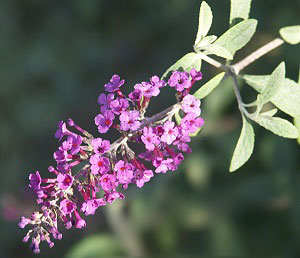

Beautiful flowering shrub, makes good cut flowers. Can be planted in very nearly any landscape site. Butterfly bush is an old favorite of many gardeners, however it's popularity comes and goes with the passage of time. Butterfly bush holds it foliage into the fall season but does not show any fall color. Butterfly bush flowers from June-July to fall and colors vary from white, pink, lavender, purple and to near red, depending on the variety. Butterfly bush prefers a well-drained, moist, loamy type soil and tolerates heat and drought after it becomes well established. Butterfly bush will attract hoards of bees and butterflies to your garden. Butterfly bush can grow 5 to 10 feet high and wide, but can be trimmed to 4 to 6 feet. The more you trim, the more it blooms.
With a name like butterfly bush, you might expect a plant to be attractive to butterflies. In fact, it's more than attractive; it's a magnet for all the butterflies who pass through your garden seeking nectar. Many butterfly gardeners plan their garden around Buddleia (pronounced BUD-lee-ah), a genus that includes over 100 species and cultivars. Also called summer lilac, the medium- to large-sized shrubs can anchor a perennial bed or form a hedge.
You'll be happier with Buddleia if you accept its growth habit, which is not neat and tidy. Its narrow branches support lilac-like clusters of blossoms a foot or two in length, with side branches and blossoms. After a rainfall, the flower-laden branches of some species can droop all over your flower bed. You'll want to allow at least six feet between bushes to keep some semblance of neatness.
But wait till you see the bush covered with fritillaries and tortoiseshells! Even a large swallowtail can land on the cluster, to sip from the many individual blooms.
Butterflies and bees will flock to the honey-scented blossoms, whose dilute nectar is sweetest in midday sun. Near a path or patio, the shrub provides delightful fragrance for you, too.
Another reason for Buddleia's popularity is that it's easy to grow, even hard to kill. Buddleia davidii tolerates urban pollution and alkaline soil. It's generally pest-free, except for spider mite infestations during drought or stress. It performs adequately in spare soil but prefers a sunny spot with well-drained soil, a light application of fertilizer in spring, and a few deep waterings in summer.